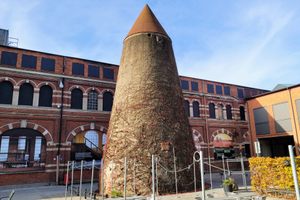
In Malmö harbor, a cone-shaped concrete relic of World War II-era architecture rises above the former dockyard like a giant vertical cigar: the Spetsbunker, a towering 60-foot (18-meter) bomb shelter.
The bunker’s construction around 1940 solved a significant challenge for the nearby then-bustling shipyard: the waterlogged, unstable ground made underground shelters impractical. Designed to protect up to 150 workers, the structure, however, ultimately went unused, as Sweden remained largely untouched by the war.
While relatively common in wartime Germany, this type of above-ground bunker is believed to be the only one of its kind in Sweden. Drawing on the pioneering work of engineer Leo Winkel, known for creating Winkeltürme (“Winkel Towers”) or Spitzbunker (“Pointed Bunkers”), the structure embodies both functionality and creativity.
The air raid shelter’s tall, narrow, circular base, with a metal-reinforced pointed top, was crafted to be nearly invisible to enemy bombers and exceptionally difficult to destroy. Even a direct hit would cause the payload to glance off the surface, rather than penetrating the walls.
Overgrown with vines, the Spetsbunker remains a stoic sentinel. Though closed to the public, its weathered interior features a spiral staircase, platforms, and a central shaft with a winch. Its distinctive silhouette continues to serve as both a historical landmark and a reminder of wartime innovation.

Post a Comment